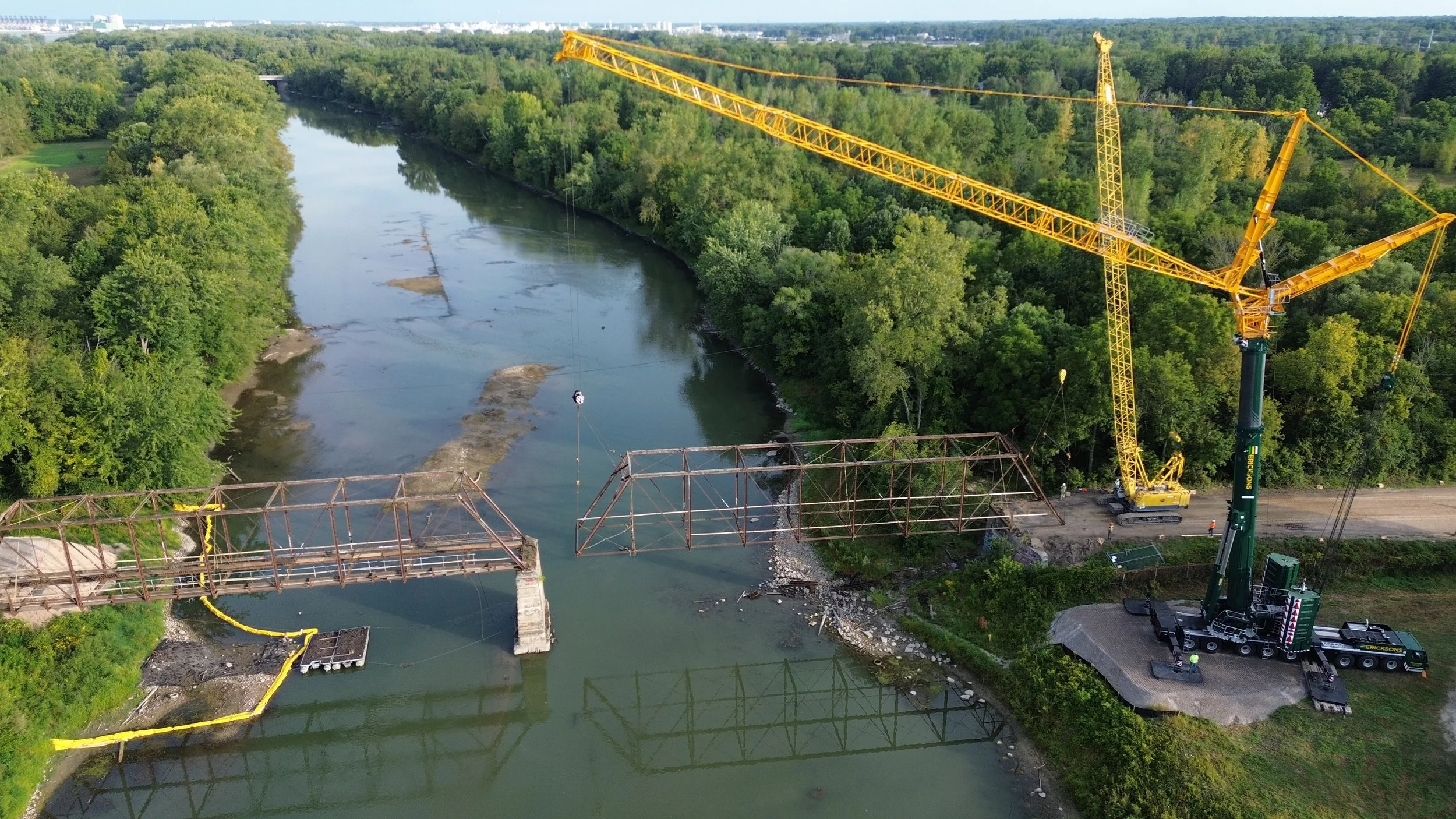Spicer Group Leads the Redevelopment of Bailey Bridge at Smiths Crossing
Spanning the Tittabawassee River in Midland County, Michigan, the historic Bailey Bridge, also widely known as the Smiths Crossing Bridge, has long stood as a regional landmark. Constructed in 1907 by the Joliet Bridge & Iron Company, this 302-foot-long, two-span Pratt Through Truss bridge is one of six remaining multi-span highway truss bridges in the state. The bridge was closed to vehicle traffic somewhere between 1979 and 1982. Pedestrians still used it until 1989, when it was completely closed down due to holes in the surface. Now, thanks to the efforts of the Great Lakes Bay Regional Trail (GLBRT) Committee, Midland County Road Commission, the Michigan Department of Transportation, other local foundations and organizations, and the work of Spicer Group, this historic structure is being restored as part of the GLBRT trail for non-motorized transportation.
The Bailey Bridge sits along what is officially labeled Smiths Crossing Road on most maps. Historical records indicate the area was once called Smith’s Crossing or Mapleton, a small settlement that has since faded, but its name remains tied to the bridge’s legacy. For years, the bridge connected local communities and supported transportation across the Tittabawassee River. Today, the bridge is poised to become a centerpiece of the regional trail system.
Spicer Group assisted the GLBRT Committee and Midland County Road Commission in securing a Transportation Alternatives Program (TAP) grant through the Michigan Department of Transportation.
“Spicer Group has been working with us the whole way on this project, going back to the initial TAP grant,” said Jon Myers, P.E., Midland County Road Commission.
Upon award of the grant, Spicer Group has continued to work on the final design and construction engineering to bring the inactive bridge back to life. The $6.63 million project is funded through a combination of local, state, and federal funds, along with generous contributions from community donors.
The project was originally slated for construction in the previous year; however, it was temporarily delayed when initial contractor bids exceeded budget constraints. With Spicer Group’s assistance, the Road Commission redesigned the project to reduce costs and re-bid the project, with construction beginning in June 2025 and completion anticipated by the end of 2026.
Spicer Group is providing professional services for the restoration, including topographic and structural surveying, design engineering, permitting, grant writing and administration, and construction engineering. The firm’s involvement is critical to ensuring that the project balances historical preservation with modern standards for safety, accessibility, and trail alignment.
From a structural standpoint, the bridge presents a rare opportunity for preservation. Its distinctive features, which include pin-connected trusses, V-lacing on sway bracing and vertical members, lattice railings, loop-forged and upset eyebars, and corrugated steel decking, offer a glimpse into early 20th-century bridge engineering.
Though some features are damaged or missing, the bridge retains enough of its original elements to warrant full rehabilitation. The restoration will preserve the historic character of the bridge while reinforcing it for safe pedestrian and bicycle use. The parts that are not salvageable will be replicated as closely as possible to the original design.
The bridge deck, which currently consists of deteriorating asphalt over corrugated steel and steel stringers, will be replaced with white oak decking. The entire structure will be cleaned, repainted, and brought back to life to enhance Michigan’s growing trail network.
“This project will be the biggest step yet in connecting the Midland trails to Freeland, Saginaw, and the rest of the trailways in Michigan,” said Myers.
Once complete, the bridge will serve as a key connector within the Great Lakes Bay Regional Trail and the state-wide Iron Belle Trail, which runs from Ironwood in the Upper Peninsula to Belle Isle State Park in Detroit. The redeveloped structure will help link the Midland County trail systems with the broader non-motorized transportation systems in the region, allowing for safer and more enjoyable transportation opportunities for walkers, runners, and cyclists.
In addition to restoring the bridge itself, the project includes the development of paved trail infrastructure. Spicer Group is overseeing the design and layout of new paved trails and roadways on either side of the bridge, helping to ensure that the restored bridge integrates seamlessly into the existing GLBRT trail network. These enhancements will improve accessibility and provide scenic views of the Tittabawassee River.
Spicer’s experience with federally funded infrastructure efforts has helped the Midland County Road Commission navigate regulatory requirements and keep the project on track despite all of the challenges encountered.
“It has been a privilege to be involved with this project because it is such a unique and historic structure,” Myers said. “Having such a rare multi-span truss bridge in our community is fantastic. Especially as an engineer, I can personally admire the one-of-a-kind structure.”
The significance of this restoration project goes beyond its engineering, transportation, and recreational value. By bringing the Bailey Bridge back into use, the project preserves an important piece of Michigan’s transportation heritage. Multi-span highway truss bridges are increasingly rare, and few are in their original location. The work being done on the Bailey Bridge ensures that future generations can appreciate the craftsmanship and historical importance of this structure, while benefiting from its modern functionality as a pedestrian and cycling route.
Construction on the Bailey Bridge restoration is currently underway, marking an exciting step forward in bringing this historic structure back into service as part of Michigan’s trail network.




